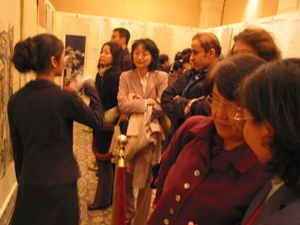Oct 23, 2004
|
|
NEW YORK "A fellow of integrity," is how the tour guide describes Pan Tianshou, whose painting of an eagle hangs in the air. The story goes that Pan once admitted to a crime he never committed because he knew he was strong and could take the beating that the real thief couldn't. For the Chinese, it's as much (if not more) about the inner meaning as it is about the lines and colors on the surface.
Last week, the Dai family of Australia held a free art exhibit of Masterpiece Chinese paintings and calligraphy from the 19th and 20th Centuries. The exhibit included works by renowned Chinese artists like Qi Baishi and Fu Baoshi. Who are they? To give you an idea, one of Fu's paintings went for $2.5 million at an auction last year. Also displayed were rare pieces painted by members of the royal family of China's Qing dynasty.
Some found the Chinese works not eye-catching enough. One man left the exhibit indifferent, saying, "They're more like drawings, not paintings."
Others had no problem relating to the more subdued Chinese style. "Very soothing, very calm," said stockbroker Lisa Moretti after looking at the collection.
A retired teacher from Florida said she was equally impressed with the exhibit, "What struck me most was that some of these artists were persecuted during the Cultural Revolution because their beliefs did not conform to communist ideology. The character of the painters really shows through."
The collection, which has been in the Dai family for four generations was previously only seen by the Dai's close family and friends. That changed when Ms. Mei-Ling Dai became afflicted with a rare and deadly disease of the immune system. She said the third time she was hospitalized she was pretty much waiting to die. That's when she was introduced to the meditation practice Falun Dafa, also known as Falun Gong. She attributes the quick turnaround in health she experienced after that to the practice.
With a new perspective on life she has made the painting collection free to the public.
Her son, Tony Dai - who now also practices Falun Dafa - said, "The founder of Falun Dafa never charges people money to learn the practice, and so we are not charging anyone for the exhibit."
The Dai's collection will be on display at the Waldorf Astoria until Sunday. After that, it will head to Japan on invitation from the Japanese royal family. In December, they have plans to return to New York and hold larger exhibits, said Tony.
Source http://english.epochtimes.com/news/4-10-23/23965.html
All content published on this website is copyrighted by Minghui.org. Minghui will produce compilations of its online content regularly and on special occasions.
Category: Falun Dafa in the Media










